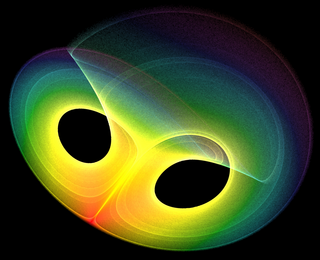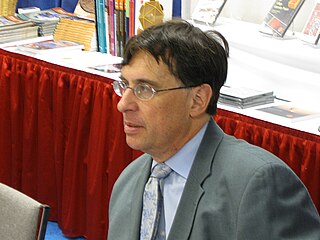Related Research Articles

Complex analysis, traditionally known as the theory of functions of a complex variable, is the branch of mathematical analysis that investigates functions of complex numbers. It is helpful in many branches of mathematics, including algebraic geometry, number theory, analytic combinatorics, applied mathematics; as well as in physics, including the branches of hydrodynamics, thermodynamics, and particularly quantum mechanics. By extension, use of complex analysis also has applications in engineering fields such as nuclear, aerospace, mechanical and electrical engineering.

In the field of complex analysis in mathematics, the Cauchy–Riemann equations, named after Augustin Cauchy and Bernhard Riemann, consist of a system of two partial differential equations which, together with certain continuity and differentiability criteria, form a necessary and sufficient condition for a complex function to be holomorphic. This system of equations first appeared in the work of Jean le Rond d'Alembert. Later, Leonhard Euler connected this system to the analytic functions. Cauchy then used these equations to construct his theory of functions. Riemann's dissertation on the theory of functions appeared in 1851.

In mathematics, a holomorphic function is a complex-valued function of one or more complex variables that is complex differentiable in a neighbourhood of each point in a domain in complex coordinate space Cn. The existence of a complex derivative in a neighbourhood is a very strong condition: it implies that a holomorphic function is infinitely differentiable and locally equal to its own Taylor series (analytic). Holomorphic functions are the central objects of study in complex analysis.

Georg Friedrich Bernhard Riemann was a German mathematician who made contributions to analysis, number theory, and differential geometry. In the field of real analysis, he is mostly known for the first rigorous formulation of the integral, the Riemann integral, and his work on Fourier series. His contributions to complex analysis include most notably the introduction of Riemann surfaces, breaking new ground in a natural, geometric treatment of complex analysis. His 1859 paper on the prime-counting function, containing the original statement of the Riemann hypothesis, is regarded as a foundational paper of analytic number theory. Through his pioneering contributions to differential geometry, Riemann laid the foundations of the mathematics of general relativity. He is considered by many to be one of the greatest mathematicians of all time.

Analysis is the branch of mathematics dealing with limits and related theories, such as differentiation, integration, measure, sequences, series, and analytic functions.
In mathematics, the uniformization theorem says that every simply connected Riemann surface is conformally equivalent to one of three Riemann surfaces: the open unit disk, the complex plane, or the Riemann sphere. The theorem is a generalization of the Riemann mapping theorem from simply connected open subsets of the plane to arbitrary simply connected Riemann surfaces.
The theory of functions of several complex variables is the branch of mathematics dealing with complex-valued functions. The name of the field dealing with the properties of function of several complex variables is called several complex variables, that has become a common name for that whole field of study and Mathematics Subject Classification has, as a top-level heading. A function is n-tuples of complex numbers, classically studied on the complex coordinate space .
In mathematics, the value distribution theory of holomorphic functions is a division of mathematical analysis. It tries to get quantitative measures of the number of times a function f(z) assumes a value a, as z grows in size, refining the Picard theorem on behaviour close to an essential singularity. The theory exists for analytic functions of one complex variable z, or of several complex variables.
In the mathematical field of complex analysis, Nevanlinna theory is part of the theory of meromorphic functions. It was devised in 1925, by Rolf Nevanlinna. Hermann Weyl called it "one of the few great mathematical events of century." The theory describes the asymptotic distribution of solutions of the equation f(z) = a, as a varies. A fundamental tool is the Nevanlinna characteristic T(r, f) which measures the rate of growth of a meromorphic function.
Complex dynamics is the study of dynamical systems defined by iteration of functions on complex number spaces. Complex analytic dynamics is the study of the dynamics of specifically analytic functions.

Mathematics encompasses a growing variety and depth of subjects over its history, and comprehension of it requires a system to categorize and organize these various subjects into more general areas of mathematics or fields of mathematics. A number of different classification schemes have arisen, and though they share some similarities, there are differences due in part to the different purposes they serve.
In mathematics, Painlevé transcendents are solutions to certain nonlinear second-order ordinary differential equations in the complex plane with the Painlevé property, but which are not generally solvable in terms of elementary functions. They were discovered by Émile Picard (1889), Paul Painlevé , Richard Fuchs (1905), and Bertrand Gambier (1910).
In mathematics, Riemann–Hilbert problems, named after Bernhard Riemann and David Hilbert, are a class of problems that arise in the study of differential equations in the complex plane. Several existence theorems for Riemann–Hilbert problems have been produced by Mark Krein, Israel Gohberg and others.
In mathematics, the term Riemann–Hilbert correspondence refers to the correspondence between regular singular flat connections on algebraic vector bundles and representations of the fundamental group, and more generally to one of several generalizations of this. The original setting appearing in Hilbert's twenty-first problem was for the Riemann sphere, where it was about the existence of systems of linear regular differential equations with prescribed monodromy representations. First the Riemann sphere may be replaced by an arbitrary Riemann surface and then, in higher dimensions, Riemann surfaces are replaced by complex manifolds of dimension > 1. There is a correspondence between certain systems of partial differential equations and possible monodromies of their solutions.
In mathematics, the Schwarz alternating method or alternating process is an iterative method introduced in 1869–1870 by Hermann Schwarz in the theory of conformal mapping. Given two overlapping regions in the complex plane in each of which the Dirichlet problem could be solved, Schwarz described an iterative method for solving the Dirichlet problem in their union, provided their intersection was suitably well behaved. This was one of several constructive techniques of conformal mapping developed by Schwarz as a contribution to the problem of uniformization, posed by Riemann in the 1850s and first resolved rigorously by Koebe and Poincaré in 1907. It furnished a scheme for uniformizing the union of two regions knowing how to uniformize each of them separately, provided their intersection was topologically a disk or an annulus. From 1870 onwards Carl Neumann also contributed to this theory.
In mathematics, the equations governing the isomonodromic deformation of meromorphic linear systems of ordinary differential equations are, in a fairly precise sense, the most fundamental exact nonlinear differential equations. As a result, their solutions and properties lie at the heart of the field of exact nonlinearity and integrable systems.
In the theory of functions of several complex variables, Hartogs's extension theorem is a statement about the singularities of holomorphic functions of several variables. Informally, it states that the support of the singularities of such functions cannot be compact, therefore the singular set of a function of several complex variables must 'go off to infinity' in some direction. More precisely, it shows that an isolated singularity is always a removable singularity for any analytic function of n > 1 complex variables. A first version of this theorem was proved by Friedrich Hartogs, and as such it is known also as Hartogs's lemma and Hartogs's principle: in earlier Soviet literature, it is also called Osgood–Brown theorem, acknowledging later work by Arthur Barton Brown and William Fogg Osgood. This property of holomorphic functions of several variables is also called Hartogs's phenomenon: however, the locution "Hartogs's phenomenon" is also used to identify the property of solutions of systems of partial differential or convolution equations satisfying Hartogs type theorems.

Steven George Krantz is an American scholar, mathematician, and writer. He has authored more than 280 research papers and more than 135 books. Additionally, Krantz has edited journals such as the Notices of the American Mathematical Society and The Journal of Geometric Analysis.
In complex analysis of one and several complex variables, Wirtinger derivatives, named after Wilhelm Wirtinger who introduced them in 1927 in the course of his studies on the theory of functions of several complex variables, are partial differential operators of the first order which behave in a very similar manner to the ordinary derivatives with respect to one real variable, when applied to holomorphic functions, antiholomorphic functions or simply differentiable functions on complex domains. These operators permit the construction of a differential calculus for such functions that is entirely analogous to the ordinary differential calculus for functions of real variables.
References
- ↑ Eremenko, A. (1982). "Meromorphic solutions of algebraic differential equations" (PDF). Russian Mathematical Surveys. 37 (4): 61–94. CiteSeerX 10.1.1.139.8499 . doi:10.1070/RM1982v037n04ABEH003967.
- ↑ So-Chin Chen; Mei-Chi Shaw (2002). Partial Differential Equations in Several Complex Variables. American Mathematical Society. ISBN 978-0-8218-2961-5.
- ↑ Complex Difference Equations of Malmquist Type Archived 2005-08-25 at the Wayback Machine
- ↑ An Introduction to complex functions on product of two time scales
- ↑ Analytic solutions to integral equations in the complex domain